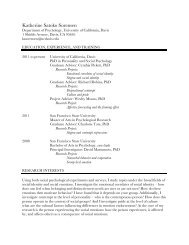SMART Board User's Guide - Psychology
SMART Board User's Guide - Psychology
SMART Board User's Guide - Psychology
You also want an ePaper? Increase the reach of your titles
YUMPU automatically turns print PDFs into web optimized ePapers that Google loves.
Presenting on the Interactive Whiteboard<br />
Tip<br />
Use Notebook software<br />
to create a presentation<br />
at your desktop<br />
computer. Store the<br />
presentation on a floppy<br />
disk, insert it in the<br />
computer attached to the<br />
board, and display the<br />
file at your meeting in<br />
Full Screen view.<br />
Alternatively, make the<br />
file accessible on your<br />
local area network.<br />
Win<br />
Tip<br />
Use the Ctrl + F<br />
keyboard shortcut to<br />
quickly open the Full<br />
Screen view.<br />
The <strong>SMART</strong> <strong>Board</strong> interactive whiteboard was designed to maximize the power of<br />
presentations. A variety of features – both hardware- and software-based – make the job of<br />
presenting information in an interactive fashion easy for the presenter and stimulating for the<br />
audience.<br />
Customizing the Notebook Interface<br />
You can easily customize the Notebook interface to suit your changing needs. For example,<br />
when developing presentation materials, use Notebook software in Normal rather than Full<br />
Screen view. All the tools required to create, import and edit annotation objects are available<br />
in this view, making it the optimal setting for creating or revising annotation objects − in other<br />
words, for creating presentations and taking notes.<br />
To present that same material on an interactive whiteboard, however, the enlarged viewing<br />
space provided in Full Screen view, free of all toolbar clutter, is preferable.<br />
Full Screen View<br />
You can use Notebook software in Normal view − that is, from a resizable, movable window<br />
with a command menu, scroll, tool and title bars − or in Full Screen view. Full Screen view<br />
maximizes available workspace on the interactive whiteboard or computer screen, filling the<br />
entire viewing area, and neither the menus, toolbar, title bar, scroll bars, Task Bar nor status<br />
bar are visible.<br />
To activate Full Screen view in a Windows operating system:<br />
1 Select Full Screen from the View menu.<br />
or<br />
Press the Full Screen button on the right side of the status bar.<br />
The Task Bar and title bar, menus, and scroll bars all disappear and the Notebook<br />
interface will appear enlarged, filling the entire interactive whiteboard.<br />
A discrete three-button toolbar will remain in view, letting you navigate through your<br />
presentation, return to Normal view and keep track of the time with the system clock.<br />
Previous/Next Page<br />
Return to<br />
Normal View<br />
2 To return to Normal view, press the Normal view button, press Alt + 1, or press the Esc<br />
key.<br />
74 <strong>SMART</strong> <strong>Board</strong> User’s <strong>Guide</strong><br />
System<br />
Clock
















